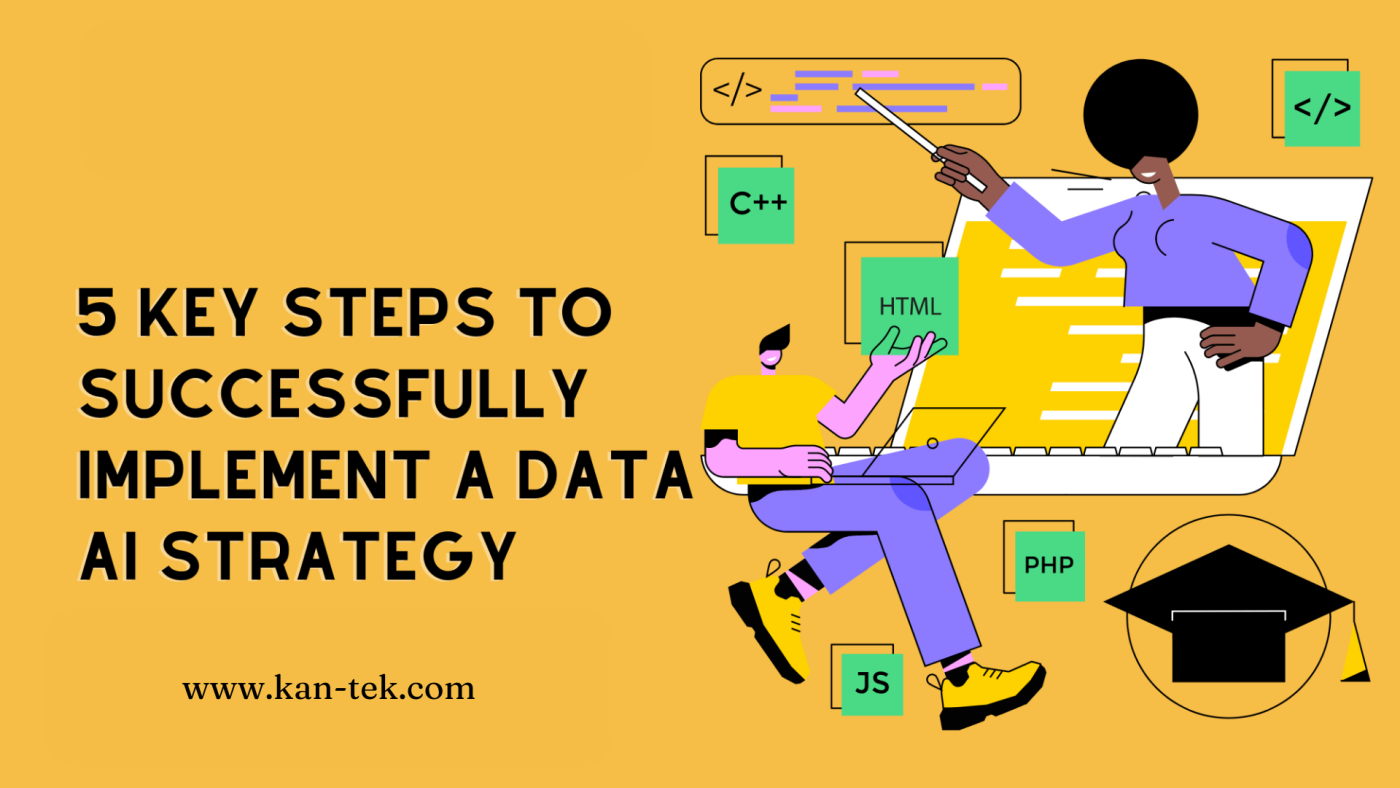Today, businesses are turning to artificial intelligence (AI) to improve operations. A well-planned data AI strategy can help organizations decide better and stay ahead of the competition. However, implementing such a strategy can be challenging. It requires careful planning and execution. Here, we will guide you through five key steps to successfully implement a data AI strategy. These steps are easy to understand, ensuring anyone can follow them.

What is Data AI Strategy?
A data AI strategy is a set of guidelines for how a company applies artificial intelligence to enhance its operations and make better decisions. It trains artificial intelligence systems using data gathered from several sources. Then, these systems can perform activities requiring human intellect, such as pattern recognition, prediction making, and process automation.
However, the company must know its objectives. It must know what it wants to do using artificial intelligence. Does it want to raise revenue, enhance customer service, or streamline processes? When decided, it compiles the required data and is ready for artificial intelligence examination.
The company then decides on appropriate artificial intelligence tools and technology for its requirements. It also develops a team that can properly handle and apply these tools. The approach calls for ongoing performance monitoring of artificial intelligence systems and necessary improvement actions. This guarantees the constant performance of the AI systems and insightful analysis.

Key Steps to Successfully Implement a Data AI Strategy
1. Define Clear Objectives & Roadmap
Clearly defining objectives is the first step in implementing a data artificial intelligence strategy. You must know the goals you wish to achieve with artificial intelligence. This can include enhancing operations’ efficiency, sales, or customer service. Well-defined goals will direct your artificial intelligence initiatives and maintain your concentration.
First, determine the issues you want AI to address. Consult several departments to learn their needs. This will help develop particular objectives. For instance, if you want to improve customer service, your aim might be to cut response times by half.
Once you have well-defined goals, jot them down. Verify that every member of your company knows them. This guarantees everyone is aiming for the same objectives. Well-defined goals are the basis of a good data artificial intelligence plan.

2. Data Value Creation & Gathering
Gathering and preparing the data comes second. Data is the fuel running artificial intelligence; your AI attempts will fail without solid data. Start by determining the information you will need to meet your goals. This could be operational, sales, or customer data.
Once you have recognized the data, you must compile it. You can accomplish this through surveys, transaction data, and internet analytics tools. Verify that the data is comprehensive and accurate. Inaccurate or incomplete data can lead to incorrect conclusions and decisions.
After gathering the data, you need to prepare it for analysis. This entails data cleaning, duplicate removal, and filling in missing values. Accurate artificial intelligence projections depend on good data preparation. However, guaranteeing the effectiveness of your data artificial intelligence plan requires time and money.
3. Choose the Right AI Tools
The third step is to choose the right AI tools. The market features several artificial intelligence tools. However, selecting the proper ones might greatly affect your artificial intelligence plan’s success. Research several artificial intelligence tools and their characteristics first. Seek tools that fit your goals and data requirements.
Think about elements including support, pricing, and simplicity of use. You want tools within your means that are simple to operate. Search also for instruments with decent customer service. Should you run across any problems during execution, this can be quite beneficial.
Once you have selected the tools, study how to apply them wisely. You should also teach your staff about their applications. This will guarantee their maximum potential.

4. Build a Skilled Team
The fourth step is developing a qualified team. A good data artificial intelligence plan requires staff with the correct competencies, including domain experts, data scientists, and artificial intelligence analysts. Start by determining your necessary talents. Then, either hire or teach others possessing these abilities.
Seek for those with a background in artificial intelligence, machine learning, and data analysis. For instance, someone with retail experience can offer insightful analysis if you work in the retail sector.
Further, invest in team training and development. Artificial intelligence is fast developing, so maintaining your workforce’s current knowledge of the newest technologies and trends is crucial.
5. Monitor and Improve
The fifth and last step is monitoring and enhancing your AI strategy. Using a data artificial intelligence approach is not a one-time endeavor. It calls for constant observation and development. To monitor your growth, first arrange key performance indicators (KPIs).
Review these KPIs often to find whether you are reaching your goals. If you are not, find the causes and act to correct them. This could require retraining your staff, changing your data, or improving your artificial intelligence algorithms.
Also, track recent developments in AI. The field is changing continually, and new tools and approaches are being developed constantly. So, staying current with these advancements will enable you to strengthen your artificial intelligence approach.
Conclusion
Implementing a data AI strategy can be challenging, but following these five key steps can make it easier. Define clear objectives, gather and prepare data, choose the right AI tools, build a skilled team, and continuously monitor and improve your strategy to ensure its success.

